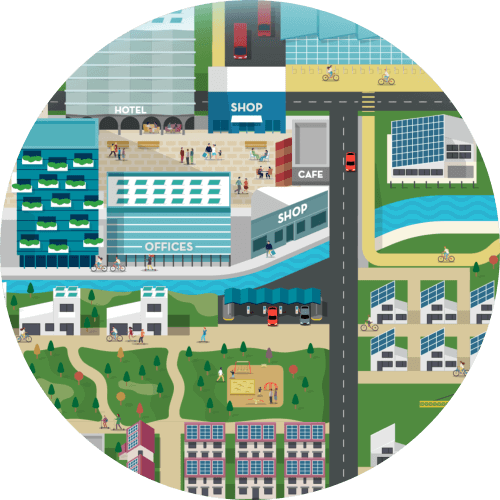See the steps your company can take towards a more sustainable future through our open resources.
Manchester Care and Repair's Climate Report
Introduction *
Commitment And Targets *
Own emissions *
Value chain emissions *
(optional)Actions and plans to reduce emissions *
Climate Solutions *
(optional)Management and strategy *
(optional)Results, challenges and outlook *
Introduction *
reporting year
*2022
number of employees in the reporting year
*30
Commitment And Targets *
net zero target year
*2050
Base year
*2022
comment on your net zero targets
*Targets apply to our \"Core\" emissions, which is Scope 1, Scope 2 and some categories of Scope 3: business travel in grey fleet, staff commute and emissions from homeworking. NB: the \'revenue\' cited above is our turnover for the year. We are a charity, and due to our structure this figure isn\'t particularly relevant as a benchmark.
near-term scope 1 target
*50
target year
*2030
near-term scope 2 target
*50
target year
*2030
near-term scope 3 target
*50
target year
*2030
comment on your near-term targets
*Targets apply to our \"Core\" emissions, which is Scope 1, Scope 2 and some categories of Scope 3: business travel in grey fleet, staff commute and emissions from homeworking.
Own emissions *
scope 1 emissions
scope 1 emissions (metric tons co2e)
*5.8
own facilities
*3.276
metric tons CO2eown vehicles
*2.284
metric tons CO2eown processes
*Not measured
scope 2 emissions
scope 2 emissions (metric tons co2e)
*1.959
total energy consumption (kwh)
*10129
renewable energy
*100
purchased electricity
*1.959
metric tons CO2eRenewable electricity (%)
100
purchased steam
*N/A
Renewable electricity (%)
-
purchased heating
*N/A
Renewable electricity (%)
-
purchased cooling
*N/A
Renewable electricity (%)
-
Comment on your energy consumption
*We report using location-based methods to hold ourselves accountable. Using a market-based method, our scope 2 emissions would be 0.
Value chain emissions (optional) *
scope 3 emissions
scope 3 emissions (metric tons co2e)
*-
supply chain related - upstream emissions
customer related - downstream emissions
Actions and plans to reduce emissions *
Scope 1 Actions
own facilities
Yes
Learn to use our new heating controls to reduce fossil gas use for our office boiler. Engage with landlord for permission to install additional energy-saving and energy-generating technology such as double-glazed windows, roof insulation, solar panels.
own vehicles
Yes
Switch our leased vehicle to an EV.
own processes
No
Tackling travel emissions from grey fleet. (Staff-opnwed cars are used for the majority of business travel and commute, and these are fossil fuel.) Install EV chargepoint for office supply and support staff to switch own vehicles to EVs. Lease a pool EV as a pilot project and use this to integrate electric vehicles into our ways of working. Engage with current staff about active transport and public transport, and integrate into induction processes. Will affect 83% of “Core” emissions: HfH travel (4%), other business travel (39%), employee commute (39%). Barrier: commercial landlord may block installation of charge points, preferring to install their own and charge higher rates. Next step: negotiate with landlord or look into ‘neighbourhood’/’community’ charging’ schemes. Barriers: electric vehicles are expensive to lease or purchase despite being cheaper to run. Solution: seek funding to purchase pool EVs (capital purchase).
scope 2 actions
purchased electricity
Yes
Engage with landlord for permission to install additional energy-saving and energy-generating technology such as double-glazed windows, roof insulation, solar panels.
purchased steam
N/A
-
purchased heating
Yes
Learn to use our new heating controls to reduce fossil gas use for our office boiler.
purchased cooling
N/A
-
scope 3 actions
supply chain related (upstream)
purchased good and services
*Yes
The vast majority of our emissions are in this category because we contract small construction jobs on beneficiaries\' homes. We are working to develop a carbon literacy training to share with our contractors, many of whom are smaller than us - using our existing network to provide sympathetic contractors with and support with their own net-zero journeys.
capital goods
*No
-
fuel and energy related activities
*Yes
See above (\'our processes\')
transportation and distribution (upstream)
*Yes
We buy locally wherever possible. Beyond that, we\'re not sure what to do as a small customer with relatively small buying power.
waste in operation
*No
-
business travel
*Yes
See above (\'our processes\')
employee commuting
*Yes
See above (\'our processes\')
upstream leased assets
*Yes
(Leased office building.) Long-term, engaging with current landlord and ultimately seeking a new landlord. BizSpace, our current landlord has no serious sustainability plan and presents a lot of options to our efforts to reduce our emissions.
customer related (downstream)
transportation and distribution (downstream)
*No
-
processing of sold products
*N/A
-
use of sold products
*No
-
end-of-life treatment of products
*No
-
leased assets (downstream)
*N/A
-
franchises
*N/A
-
investments
*No
-
i have asked my suppliers to halve emissions before 2030 and join the un-backed race to zero campaign
*No
i have communicated my commitment and actions to my business customers and asked them to join the un race to zero
*No
Climate Solutions (optional) *
Management and strategy (optional) *
Results, challenges and outlook *

Manchester Care and Repair's Climate Report
Manchester Care and Repair's Climate Report - 2022
Introduction *
reporting year
*2022
number of employees in the reporting year
*30
Commitment And Targets *
net zero target year
*2050
Base year
*2022
comment on your net zero targets
*Targets apply to our \"Core\" emissions, which is Scope 1, Scope 2 and some categories of Scope 3: business travel in grey fleet, staff commute and emissions from homeworking. NB: the \'revenue\' cited above is our turnover for the year. We are a charity, and due to our structure this figure isn\'t particularly relevant as a benchmark.
near-term scope 1 target
*50
target year
*2030
near-term scope 2 target
*50
target year
*2030
near-term scope 3 target
*50
target year
*2030
comment on your near-term targets
*Targets apply to our \"Core\" emissions, which is Scope 1, Scope 2 and some categories of Scope 3: business travel in grey fleet, staff commute and emissions from homeworking.
Own emissions *
scope 1 emissions
scope 1 emissions (metric tons co2e)
*5.8
own facilities
*3.276
metric tons CO2eown vehicles
*2.284
metric tons CO2eown processes
*Not measured
scope 2 emissions
scope 2 emissions (metric tons co2e)
*1.959
total energy consumption (kwh)
*10129
renewable energy
*100
purchased electricity
*1.959
metric tons CO2eRenewable electricity (%)
100
purchased steam
*N/A
Renewable electricity (%)
-
purchased heating
*N/A
Renewable electricity (%)
-
purchased cooling
*N/A
Renewable electricity (%)
-
Comment on your energy consumption
*We report using location-based methods to hold ourselves accountable. Using a market-based method, our scope 2 emissions would be 0.
Value chain emissions (optional) *
scope 3 emissions
scope 3 emissions (metric tons co2e)
*-
supply chain related - upstream emissions
customer related - downstream emissions
Actions and plans to reduce emissions *
Scope 1 Actions
own facilities
Yes
Learn to use our new heating controls to reduce fossil gas use for our office boiler. Engage with landlord for permission to install additional energy-saving and energy-generating technology such as double-glazed windows, roof insulation, solar panels.
own vehicles
Yes
Switch our leased vehicle to an EV.
own processes
No
Tackling travel emissions from grey fleet. (Staff-opnwed cars are used for the majority of business travel and commute, and these are fossil fuel.) Install EV chargepoint for office supply and support staff to switch own vehicles to EVs. Lease a pool EV as a pilot project and use this to integrate electric vehicles into our ways of working. Engage with current staff about active transport and public transport, and integrate into induction processes. Will affect 83% of “Core” emissions: HfH travel (4%), other business travel (39%), employee commute (39%). Barrier: commercial landlord may block installation of charge points, preferring to install their own and charge higher rates. Next step: negotiate with landlord or look into ‘neighbourhood’/’community’ charging’ schemes. Barriers: electric vehicles are expensive to lease or purchase despite being cheaper to run. Solution: seek funding to purchase pool EVs (capital purchase).
scope 2 actions
purchased electricity
Yes
Engage with landlord for permission to install additional energy-saving and energy-generating technology such as double-glazed windows, roof insulation, solar panels.
purchased steam
N/A
-
purchased heating
Yes
Learn to use our new heating controls to reduce fossil gas use for our office boiler.
purchased cooling
N/A
-
scope 3 actions
supply chain related (upstream)
purchased good and services
*Yes
The vast majority of our emissions are in this category because we contract small construction jobs on beneficiaries\' homes. We are working to develop a carbon literacy training to share with our contractors, many of whom are smaller than us - using our existing network to provide sympathetic contractors with and support with their own net-zero journeys.
capital goods
*No
-
fuel and energy related activities
*Yes
See above (\'our processes\')
transportation and distribution (upstream)
*Yes
We buy locally wherever possible. Beyond that, we\'re not sure what to do as a small customer with relatively small buying power.
waste in operation
*No
-
business travel
*Yes
See above (\'our processes\')
employee commuting
*Yes
See above (\'our processes\')
upstream leased assets
*Yes
(Leased office building.) Long-term, engaging with current landlord and ultimately seeking a new landlord. BizSpace, our current landlord has no serious sustainability plan and presents a lot of options to our efforts to reduce our emissions.
customer related (downstream)
transportation and distribution (downstream)
*No
-
processing of sold products
*N/A
-
use of sold products
*No
-
end-of-life treatment of products
*No
-
leased assets (downstream)
*N/A
-
franchises
*N/A
-
investments
*No
-
i have asked my suppliers to halve emissions before 2030 and join the un-backed race to zero campaign
*No
i have communicated my commitment and actions to my business customers and asked them to join the un race to zero
*No
Climate Solutions (optional) *
Management and strategy (optional) *
Results, challenges and outlook *
Not sure how to start?
See the steps you can take and get help building a plan to cut your business emissions today.
¿No estás seguro de por dónde empezar?
Revisa los pasos que puedes dar y obtén ayuda para elaborar un plan para reducir las emisiones de tu empresa hoy mismo.
لست متأكداً كيف تبدأ؟
اطلع على الخطوات التي يمكنك اتخاذها واحصل على المساعدة في وضع خطة لخفض انبعاثات شركتك اليوم.
Vous ne savez pas par où commencer ?
Découvrez les mesures que vous pouvez prendre et obtenez de l’aide pour élaborer un plan pour réduire les émissions de votre entreprise dès aujourd’hui.
Ready to commit to lower emissions?
It’s easy to make the commitment. Just complete a form sharing your intent to reduce your emissions.
You’ll earn public recognition for taking the first step.
¿Listo para comprometerte a reducir tus emisiones?
Es fácil comprometerse. Solo tienes que completar un formulario compartiendo tu intención de reducir tus emisiones.
Ganarás reconocimiento público por tomar este primer paso.
هل أنت مستعد للالتزام بتقليل الانبعاثات؟
الالتزام سهل. ما عليك سوى تعبئة نموذج لمشاركة عزمك على تقليل انبعاثاتك.
سوف تحظى باعتراف عام باتخاذك الخطوة الأولى.
Prêt à vous engager pour réduire les émissions ?
S’engager est simple. Il suffit de remplir un formulaire indiquant votre intention de réduire vos émissions.
Vous gagnerez une reconnaissance publique pour avoir fait le premier pas.
Register now to use our tools
Register now to use our tools

Stay updated!
Sign up for our newsletter to stay updated with the latest climate developments.
Log in
Don't have an account? Create account to access our tools or make the SME Climate Commitment
Log in
Don't have an account? Create account to access our tools or make the SME Climate Commitment
Log in
Don't have an account? Create account to access our tools or make the SME Climate Commitment
Forgot password?
Please enter your email address. You will receive a link to create a new password via email.

 Go back
Go back

